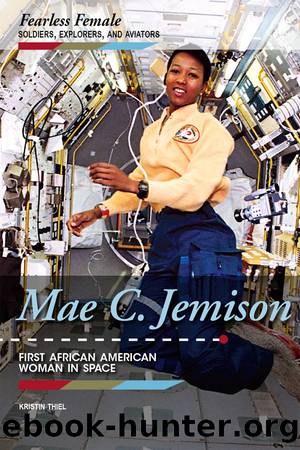Mae C. Jemison by Kristin Thiel

Author:Kristin Thiel
Language: eng
Format: epub
Publisher: Cavendish Square Publishing, LLC
Published: 2019-01-08T00:00:00+00:00
Inspiring the Next Generation
Under the Dorothy Jemison Foundation for Excellence, which Jemison founded in memory of her mother, The Earth We Share (TEWS) provides students ages twelve to sixteen from around the world with science education in a camp setting. Over four weeks each year, students participating in TEWS build critical-thinking and problem-solving skills in science settings. Science has a broad definition with varied practical applications to Jemison. She said the TEWS students âdo things like predict the hot public stocks of the year 2030, and design the worldâs perfect house.â
In October 2006, the Dorothy Jemison Foundation hosted the symposium Reality Leads Fantasy: Celebrating Women of Color in Flight. TEWS-Space Race launched in the summer of 2011 with a focus on Los Angeles-area students underserved and underrepresented in the sciences. It educates middle-school students and trains teachers.
Propelling Humanity into the Beyond
Jemison is the principal of 100 Year Starship, an initiative to ensure that within the next century all the capabilities exist to send humans to another star system, making use of human power across race, ethnicity, gender, geography, and discipline. As audacious a proposal as that is, Jemison has made it clear that inclusivity is the initiativeâs main focus. The program has been funded by the US Department of Defenseâs Defense Advanced Research Project Agency (DARPA). That said, Jemison explained, the initiative is not about war, and itâs not really about meeting such a specific travel goal as reaching another star system in the next hundred years.
To reach far outer space would be cool, but it would be so difficult to accomplish, Jemison explained. We need new fuel technology and new life-support technology in order to do that. To explain, she suggested we imagine Los Angeles is Earth and New York City is Alpha Centauri, Earthâs closest neighboring star. The Voyager spaceship has been traveling at 35,000 miles per hour (56,325 kmh) since 1977; on the Los Angeles-to-New York scale, itâs gone only 1 mile (1.6 km). This means, with the technology we have today, it will take us seventy thousand years to reach Alpha Centauri. That said, one of the initiatives of 100 Year Starship has been working on building an actual starship through intense workshops, and the group held a big public symposium in Silicon Valley in October 2015. In August 2016, NASA itself announced a Mars program, funded by public and private money and spearheaded by six companies in addition to NASA. The group has two years to develop concept studies.
We need to be able to travel faster to have any hope of reaching somewhere far away within the span of a human life. We canât use chemical rockets; we need to be able to use fission and fusion, and generate and store that energy. Even if we could vastly increase our speed and cut our travel time to fifty years, weâd still have to figure out closed environmental life support systems. At that speed, you canât stop for supplies. You have to pack everything you will need for your entire multiyear journey on the ship.
Download
This site does not store any files on its server. We only index and link to content provided by other sites. Please contact the content providers to delete copyright contents if any and email us, we'll remove relevant links or contents immediately.
Pale Blue Dot by Carl Sagan(4887)
Cracking the GRE Premium Edition with 6 Practice Tests, 2015 (Graduate School Test Preparation) by Princeton Review(4206)
Pocahontas by Joseph Bruchac(4167)
Unfiltered by Lily Collins(3947)
The Emotionary: A Dictionary of Words That Don't Exist for Feelings That Do by Eden Sher(3301)
The Daily Stoic by Holiday Ryan & Hanselman Stephen(3215)
Factfulness_Ten Reasons We're Wrong About the World_and Why Things Are Better Than You Think by Hans Rosling(3187)
The President Has Been Shot!": The Assassination of John F. Kennedy by Swanson James L(3035)
The 48 laws of power by Robert Greene & Joost Elffers(2994)
Sapiens and Homo Deus by Yuval Noah Harari(2970)
Rogue Trader by Leeson Nick(2962)
The Innovators: How a Group of Hackers, Geniuses, and Geeks Created the Digital Revolution by Walter Isaacson(2784)
The Rape Of Nanking by Iris Chang(2764)
Gettysburg by Iain C. Martin(2717)
Almost Adulting by Arden Rose(2645)
The Plant Paradox by Dr. Steven R. Gundry M.D(2531)
500 Must-Know AP Microeconomics/Macroeconomics Questions(2520)
In the Woods by Tana French(2520)
Make by Mike Westerfield(2274)
